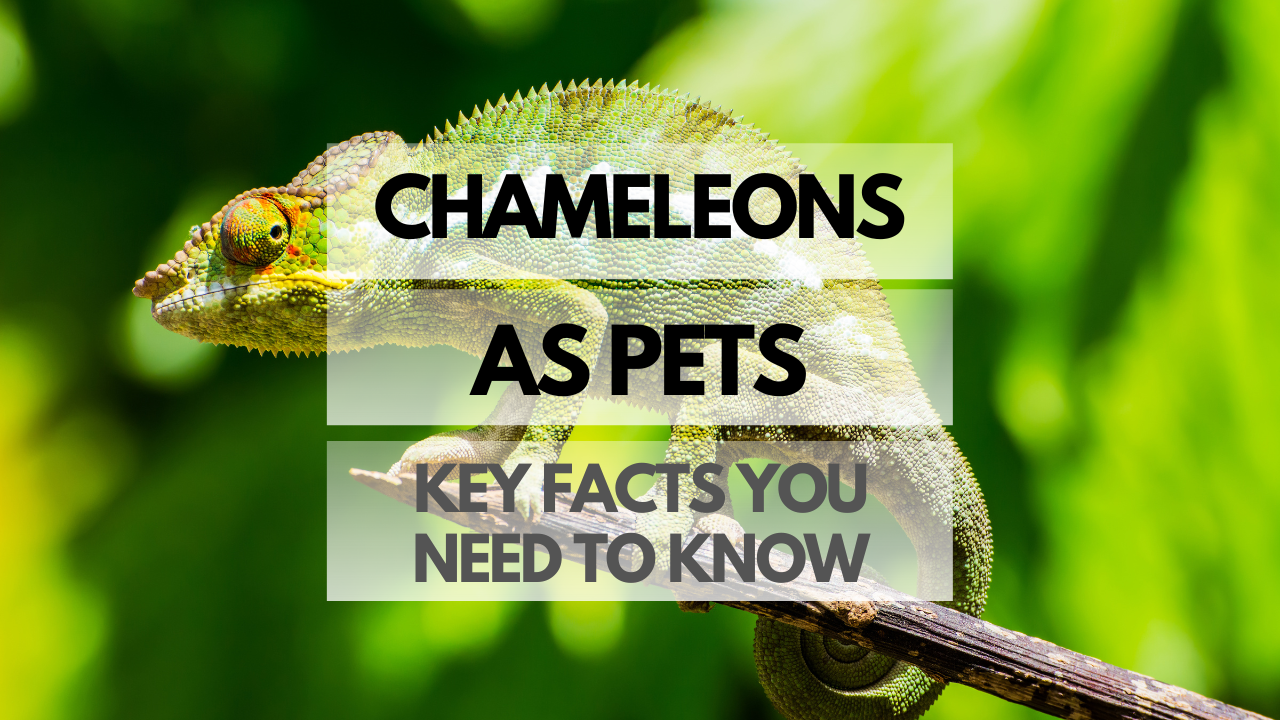Chameleons are fascinating creatures with their unique ability to change colors, move their eyes independently, and their impressive balance with their prehensile tails. These extraordinary reptiles have become increasingly popular as pets due to their intriguing nature and captivating appearance. In this article, we’ll dive into everything you need to know about keeping chameleons as pets, from their behavior and temperament to the care they require.
Quick Reference Table: Chameleon Facts
| Fact | Details |
|---|---|
| Size | Varies by species; 1-30 inches in length |
| Lifespan | 2-10 years, depending on species |
| Native habitat | Primarily Africa and Madagascar, some in Asia and Europe |
| Temperament | Generally solitary and shy |
| Care level | Intermediate to advanced |
| Diet | Primarily insectivores |
How Are Chameleons as Pets?
Chameleons can make fascinating and rewarding pets for those willing to put in the time and effort to care for them properly. They are not ideal for beginners or those looking for a pet to handle frequently, as they are generally shy and prefer not to be touched. However, with the right care, they can thrive in a captive environment and provide endless entertainment and fascination.
Pros and Cons of Chameleons
Pros: Unique and captivating appearance, interesting behaviors, wide variety of species and colors.
Cons: Require specialized care, not suitable for handling, can be sensitive to stress, some species have a short lifespan.
Chameleon Behavior and Temperament
Chameleons are generally solitary, shy creatures that prefer to avoid confrontation. They can become stressed if handled too frequently or placed in an environment with too much activity. Observing their natural behaviors, such as hunting insects and changing colors, can be a rewarding experience for pet owners.
How Much Do Chameleons Cost?
Chameleon prices can vary significantly depending on the species, ranging from $30 to several hundred dollars. Initial setup costs, such as the purchase of an appropriate enclosure, heating and lighting equipment, and furnishings, can also be substantial. Ongoing expenses include food, supplements, and occasional replacement of equipment or furnishings.
Chameleon Lifespan: Time and Commitment
Chameleon life expectancy varies depending on the species, with some living only a few years and others potentially reaching up to 10 years. As with any pet, owning a chameleon requires a commitment to providing proper care throughout their life. They also need consistent monitoring and maintenance of their enclosure to ensure a healthy environment.
Chameleon Size
Chameleon size varies greatly depending on the species. Some smaller species, like the Pygmy chameleon, may only reach 1-3 inches in length, while larger species, such as the Parsons chameleon, can exceed 30 inches. It is essential to consider the adult size of the specific chameleon species you are interested in when planning their enclosure and care.
Chameleon Species
Panther Chameleon
Panther chameleons are native to Madagascar and are known for their striking colors and patterns. Males typically display more vibrant colors than females.
Veiled Chameleon
Veiled chameleons are native to Yemen and Saudi Arabia and have a distinctive casque on their head. They are a popular choice for beginners due to their hardy nature and adaptability.
Jackson’s Chameleon
Native to East Africa, Jackson’s chameleons are known for their unique three-horned appearance. They give live birth, unlike most chameleon species that lay eggs.
Other Species
There are many other chameleon species available in the pet trade, each withtheir own unique appearance and care requirements. Some examples include the Carpet chameleon, the Oustalet’s chameleon, and the Graceful chameleon.
Chameleon Colors, Looks and Appearances
Chameleons are famous for their ability to change colors, which they do for various reasons such as communication, temperature regulation, or camouflage. Each species has its own unique color patterns and combinations, ranging from bright blues, greens, and yellows to more subdued browns and grays.
Chameleon Care Guide
Chameleons require specialized care to thrive in captivity. This includes providing an appropriate environment, a proper diet, and monitoring their health closely. The following sections offer an overview of essential aspects of chameleon care.
Chameleon Habitat: Tank and Housing
Appropriate Chameleon Tank Size
The appropriate tank size for a chameleon depends on the species and their adult size. Generally, a tall, vertically-oriented enclosure is preferred, as chameleons are arboreal and enjoy climbing. A minimum of 16″x16″x30″ is recommended for smaller species, while larger species require more space.
Types of Enclosures
Screened enclosures are popular for chameleons due to their excellent ventilation, which helps prevent respiratory issues. Glass enclosures can also be used but require careful monitoring of humidity and temperature levels.
Substrate Options
Substrate is not always necessary for chameleon enclosures, as they typically spend most of their time off the ground. If desired, a simple, easy-to-clean substrate like newspaper or paper towels can be used. Avoid using small, loose particles, as chameleons can accidentally ingest them while hunting.
Heating and Lighting Requirements
Chameleons require a heat source, such as a basking light, to regulate their body temperature. They also need access to UVB lighting to synthesize vitamin D3, which is essential for calcium absorption. The appropriate temperature range and UVB output depend on the specific species.
Humidity and Temperature Control
Proper humidity levels are crucial for chameleons, as they help prevent dehydration and shedding issues. This can be achieved by misting the enclosure regularly and using a hygrometer to monitor humidity levels. The ideal temperature range depends on the species, but generally, a gradient from 70-90°F is recommended.
Furnishings and Decorations
Chameleon enclosures should include plenty of vertical climbing space, such as branches, vines, and plants (both live and artificial). They also appreciate hiding spots to retreat to when they feel threatened or stressed.
Cleaning and Maintenance
Regular cleaning and maintenance of the enclosure are crucial to prevent the buildup of bacteria and ensure a healthy environment for your chameleon. This includes spot cleaning daily, removing uneaten food and waste, and conducting a thorough cleaning of the entire enclosure every few weeks.
Chameleon Food: Diet and Nutrition
Feeding Frequency and Schedule
Chameleons are primarily insectivores, and their feeding schedule depends on their age, size, and species. Juveniles typically require daily feedings, while adults can be fed every other day or a few times per week.
What do Chameleons Eat?
Chameleons eat a variety of insects, such as crickets, roaches, and worms. It is essential to provide a diverse diet and gut-load feeder insects with nutritious fruits and vegetables before feeding them to your chameleon.
Chameleon Treats
Treats for chameleons may include waxworms, hornworms, or the occasional fruit, depending on the species. Treats should be offered sparingly, as they can be high in fat or sugar.
Foods to Avoid
Avoid feeding chameleons insects that have been caught outdoors, as they may carry parasites or be contaminated with pesticides. Additionally, avoid offering insects that are too large, as this can cause choking or impaction.
Supplements and Vitamins
Chameleons require calcium and vitamin D3 supplements to maintain healthy bones and prevent metabolic bone disease. These supplements can be dusted onto feeder insects before offering them to your chameleon.
Hydration
Proper hydration is essential for a chameleon’s health and well-being. Chameleons don’t drink water from a bowl like most pets, so you’ll need to provide them with a dripping water source or mist their enclosure regularly. Some chameleon keepers use a drip system or an automatic misting system to maintain consistent humidity levels within the enclosure.
Handling and Socialization
Chameleons are not the most social animals, and they generally don’t enjoy being handled. However, with proper care, patience, and training, you can establish a bond with your chameleon and handle them safely and comfortably.
Taming and Bonding
To tame and bond with your chameleon, start by approaching them slowly and calmly. Offer treats like insects or small pieces of fruit to help build trust. Over time, your chameleon should become more comfortable with your presence and may even climb onto your hand willingly. Be patient and consistent with your interactions, and never force your chameleon to do anything they’re uncomfortable with.
Safe Handling Techniques
When handling your chameleon, always support their body with one hand while gently guiding them with the other. Avoid gripping or squeezing them, as this can cause stress and injury. Be mindful of their delicate skin and fragile bones, and always move slowly and calmly.
Signs of Stress and Illness
Chameleons can become stressed or ill if not cared for properly. Signs of stress include pacing, rapid breathing, and dark coloration. If your chameleon is showing any of these signs, try to identify the cause and address it as soon as possible. Common causes of stress include improper temperature or humidity, inadequate hiding spots, or poor handling techniques.
Introducing Chameleons to Other Pets
Chameleons should be kept separately from other pets, as they are solitary animals and can become stressed or aggressive when housed with other animals. If you have multiple chameleons, provide each with their own enclosure to ensure their safety and well-being.
Health and Wellness
Keeping your chameleon healthy requires attention to their environment, diet, and overall well-being. Here are some important aspects of chameleon health and wellness to consider:
Common Health Issues
Some common health issues that can affect chameleons include metabolic bone disease, respiratory infections, and parasites. To prevent these issues, provide a proper diet, maintain appropriate temperature and humidity levels, and keep a clean and hygienic enclosure.
Signs of a Healthy Chameleon
A healthy chameleon will have clear eyes, smooth skin, and a strong grip. They should be active and alert, with a good appetite for insects and vegetation. Regularly observe your chameleon for any changes in behavior or appearance that could indicate a health issue.
Preventative Care
To keep your chameleon healthy, be proactive with their care. This includes providing a balanced diet, maintaining proper temperature and humidity, and ensuring their enclosure is clean and secure. Regularly monitor your chameleon’s health and consult a reptile veterinarian if you have any concerns.
Finding a Reptile Veterinarian
Not all veterinarians are experienced with reptiles, so it’s important to find one who specializes in chameleon care. Ask for recommendations from fellow chameleon owners, local reptile clubs, or online forums. Establish a relationship with a qualified reptile veterinarian and schedule regular check-ups to ensure your chameleon’s continued health.
Breeding and Reproduction
Breeding chameleons can be a rewarding experience, but it requires careful planning and preparation. Here’s what you need to know about chameleon reproduction:
Determining Gender
Male and female chameleons often have distinct physical characteristics that can help you determine their gender. Males may have larger or more colorful bodies, while females may have a more subdued appearance. Consult a reputable care guide or reptile veterinarian for guidance on sexing your specific chameleon species.
MatingBehavior and Courtship
Chameleons have unique mating behaviors and courtship displays that can vary by species. Males may bob their heads, puff out their throats, or display bright colors to attract a female. Females may show receptive or non-receptive coloration to signal their readiness to mate. Ensure that you understand the specific mating behaviors of your chameleon species before attempting to breed them.
Gravidity and Egg-laying
After mating, female chameleons will become gravid and develop eggs. Provide a suitable laying site, such as a container filled with moistened substrate, for the female to deposit her eggs. The gestation period and number of eggs laid can vary by species, so research your specific chameleon’s reproductive habits for the best results.
Incubation and Hatching
Chameleon eggs require proper temperature and humidity levels for successful incubation. Monitor the conditions closely and make adjustments as needed. Hatching times can vary by species, but most chameleon eggs will hatch within 2-6 months. Be prepared to separate the hatchlings into their own enclosures to ensure proper care and growth.
Caring for Hatchlings
Chameleon hatchlings require special care, including a smaller enclosure with appropriate hiding spots, temperature, and humidity. Offer a varied diet of small insects to support their growth and development. Maintain a clean environment and monitor the hatchlings closely for signs of health issues.
Are Chameleons Legal?
Chameleon legality varies by country, state, and local jurisdiction. Before acquiring a chameleon as a pet, research your area’s laws and regulations to ensure that you can legally keep one. Some regions may require permits or have restrictions on specific species, so it’s important to be informed and comply with all applicable laws.
Popular Names for Chameleons
Choosing a name for your chameleon can be a fun and creative process. Here are some popular and unique names to consider:
- Karma
- Pascal
- Rango
- Chroma
- Sherbet
- Camille
- Waldo
- Ziggy
- Chameleonardo
- Emerald
Conclusion: Should You Own Chameleons as Pets?
Chameleons can make fascinating and rewarding pets for those who are willing to invest the time, effort, and resources into their proper care. They have unique personalities and captivating behaviors that can provide endless entertainment and companionship. However, chameleons also require specialized care and attention to thrive. If you’re prepared to meet their needs and provide a stable, loving environment, a chameleon can be a wonderful addition to your life. Embrace the joys and challenges of chameleon ownership and enjoy the unique bond you’ll form with your new scaly friend.
FAQ for Pet Chameleons
- Q: Are Chameleons good pets?
- A: Chameleons can be good pets for the right person who is willing to invest the time, effort, and resources into their proper care. They are unique and fascinating creatures but require specialized care and attention.
- Q: Can Chameleons eat grapes?
- A: Chameleons can eat grapes occasionally as a treat, but their main diet should consist of insects and other suitable protein sources.
- Q: Can Chameleons eat bananas?
- A: Chameleons can eat bananas in moderation, but it should not be a staple in their diet. Focus on providing a variety of insects and other protein sources for a balanced diet.
- Q: Can Chameleons eat strawberries?
- A: Chameleons can eat strawberries occasionally as a treat, but their primary diet should consist of insects and other suitable protein sources.
- Q: Can Chameleons eat apples?
- A: Chameleons can eat small amounts of apples occasionally, but their main diet should consist of insects and other appropriate protein sources.
- Q: Can Chameleons eat spinach?
- A: It is best to avoid feeding chameleons spinach, as it contains oxalates that can interfere with calcium absorption. Offer a variety of other leafy greens and vegetables instead.
- Q: Can Chameleons eat tomatoes?
- A: Chameleons can eat tomatoes occasionally, but their primary diet should consist of insects and other suitable protein sources.
- Q: Can Chameleons eat carrots?
- A: Chameleons can eat small amounts of carrots as an occasional treat, but their main diet should consist of insects and other appropriate protein sources.
- Q: Can Chameleons eat cucumbers?
- A: Chameleons can eat cucumbers occasionally, but their primary diet should consist of insects and other suitable protein sources.
- Q: Can Chameleons eat watermelon?
- A: Chameleons can eat watermelon occasionally as a treat, but their main diet should consist of insects and other appropriate protein sources.
- Q: Can Chameleons eat broccoli?
- A: Chameleons can eat small amounts of broccoli occasionally, but their primary diet should consist of insects and other suitable protein sources.
- Q: Can Chameleons eat blueberries?
- A: Chameleons can eat blueberries occasionally as a treat, but their main diet should consist of insects and other appropriate protein sources.
- Q: Can Chameleons eat celery?
- A: Chameleons can eat small amounts of celery occasionally, but their primary diet should consist of insects and other suitable protein sources.
- Q: Can Chameleons eat cabbage?
- A: Chameleons can eat small amounts of cabbage occasionally, but their main diet should consist of insects and other appropriate protein sources.
- Q: Can Chameleons eat cilantro?
- A: Chameleons can eat cilantro occasionally, but their primary diet should consist of insects and other suitable protein sources.
- Q: Can Chameleons eat kale?
- A: Chameleons can eat small amounts of kale occasionally, but their main diet should consist of insects and other appropriate protein sources.
- Q: Can Chameleons eat blackberries?
- A: Chameleons can eat blackberries occasionally as a treat, but their primary diet should consist of insects and other suitable protein sources.
- Q: Can Chameleons eat oranges?
- A: Chameleons can eat small amounts of oranges occasionally, but their main diet should consist of insects and other appropriate protein sources.
- Q: Can Chameleons eat avocados?
- A: No, chameleons should not eat avocados, as they can be toxic to reptiles. Stick to a diet of insects and other suitable protein sources.
- Q: Can Chameleons eat corn?
- A: Chameleons can eat small amounts of corn occasionally, but their primary diet should consist of insects and other suitable protein sources.
- Q: Can Chameleons eat asparagus?
- A: Chameleons can eat small amounts of asparagus occasionally, but their main diet should consist of insects and other appropriate protein sources.
- Q: How often do Chameleons eat?
- A: Chameleons typically eat daily. Juvenile chameleons may need to be fed multiple times a day, while adult chameleons can be fed once a day or every other day, depending on their specific needs.
- Q: How long do Chameleons live?
- A: The lifespan of chameleons varies depending on the species. Some smaller species may live for 2-3 years, while larger species can live up to 10 years or more with proper care.
- Q: Where are Chameleons native?
- A: Chameleons are native to Africa, Madagascar, and parts of southern Europe, the Middle East, and southern Asia.
- Q: Are Chameleons friendly?
- A: Chameleons are not typically considered “friendly” pets, as they are solitary animals that prefer limited handling. They can be fascinating to observe but are not ideal for those seeking a more interactive pet.
- Q: Do Chameleons bite?
- A: Chameleons can bite if they feel threatened or stressed. However, they are not known for being aggressive and will usually try to avoid confrontation.
- Q: Do Chameleons like to be held?
- A: Chameleons generally do not enjoy being held and prefer limited handling. Excessive handling can cause stress, which can negatively affect their health.
- Q: Are Chameleons nocturnal?
- A: Most chameleon species are diurnal, meaning they are active during the day and sleep at night.
- Q: Do Chameleons pee?
- A: Chameleons excrete waste in the form of urates, a semi-solid substance that contains waste products from their metabolism. They do not urinate like mammals.
- Q: Do Chameleons hibernate?
- A: Chameleons do not hibernate, but they may become less active during cooler months or periods of reduced daylight in their natural habitat.
- Q: Do Chameleons make noise?
- A: Chameleons are generally quiet animals and do not make noise like some other pets. However, they may hiss or make other subtle sounds when threatened or stressed.
- Q: Are Chameleons venomous or poisonous?
- A: Chameleons are not venomous or poisonous. They are harmless to humans and other animals, apart from their prey, which consists mainly of insects.
- Q: Are Chameleons smart?
- A: Chameleons are intelligent animals with the ability to learn and adapt to their environment. They possess unique adaptations, such as color-changing abilities and independently moving eyes, to help them navigate their surroundings and avoid predators.
- Q: Do Chameleons need heat at night?
- A: Chameleons generally require a temperature drop at night to mimic their natural environment. However, if the temperature drops too low, a low-wattage heat source may be needed to maintain an appropriate temperature range for the species.
- Q: Do Chameleons lay eggs?
- A: Most chameleon species lay eggs, while a few give birth to live young. The reproductive habits of chameleons vary depending on the species.
- Q: Do Chameleons smell?
- A: Chameleons do not have a strong odor, but their enclosures can develop an unpleasant smell if not cleaned regularly. Proper husbandry, including routine cleaning, will help keep their environment fresh and odor-free.









